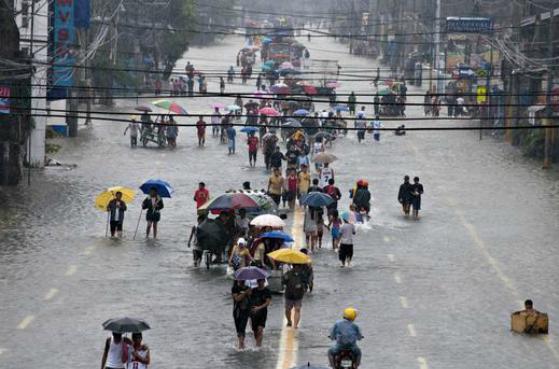It is increasingly important to involve new circles of professionals in the response to climate change. But many still have a limited understanding of the issues. The common misconception that mitigating climate change requires sacrificing economic growth and human development is prevalent among many professionals from both the EU and China – including lawyers.
I realised this last month during participation in the 22nd EU-China Human Rights Seminar at the University of Galway, Ireland, where one of the topics was human rights and the environment, and during an EU-China Dialogue at the Law Faculty of China’s Renmin University on the topic of “common but differentiated responsibilities”.
The most recent EU emissions data demonstrate it is possible to grow the economy while reducing emissions. Despite a 48% GDP increase since 1990, greenhouse-gas emissions in the EU-27 have decreased by 18% since 1990. Including offsets generated through the CDM, the reductions are even higher – around 20%. The EU has, therefore, already achieved its reduction target for 2020 nine years early, though not yet increased its target for 2020. Closer cooperation between the EU and China is needed, however, to address the issue of embodied emissions in products manufactured in China and consumed in Europe.
The cost of decarbonisation is not as high as often perceived, especially if early action is taken. According to new research by the Potsdam Institute for Climate Impact Research, immediate climate policy can contain the mitigation costs at less than 1% of global GDP, even if the CO2 concentration target is 410 parts per million (ppm) by 2100. Delayed climate policy, however – the kind we are seeing in most countries right now – increases the costs significantly, as the absence of a strong carbon price signal continues to push the world along a carbon intensive growth path.
So what role do lawyers have to play? Taking a rights-based approach to the climate-change question is important and legal experts can make important contributions in debates about responsibilities and equity. In the context of the UN climate change negotiations, the conventional “right to development” is already complemented by a new concept: the right to ”equitable access to sustainable development”. This approach not only considers climate protection, but also global equity principles.
The exact definition of equity and application of the equity principle are not yet clear and will continue to be discussed in Doha this week. Still, this step forward means high-carbon economic development according to business-as-usual cannot be considered a collective or individual right as it impacts negatively on the right to sustainable development of other countries and future generations.
The historical emissions of rich countries since the industrial revolution have already significantly reduced the available atmospheric space for developing countries to emit greenhouse gases. Although EU carbon-dioxide emissions dropped by 3% to 7.5 tonnes per capita in 2011, the EU has significant responsibility to act on climate change due to its contribution of historical emissions.
In other words, the atmosphere is already over-occupied by greenhouse-gas emissions from developed countries. And the already emitted greenhouse gases responsible for the warming we can observe today are already negatively impacting many of the world’s least developed countries through extreme weather events such as droughts and floods.
At the beginning of the 21st century, it is not only the emissions of industrialised countries that are impacting on the development space of developing countries. The fast growing economies of the BASIC countries – Brazil, South Africa, India and China – are also responsible for a fast growing share of current and future global emissions.
One useful tool in this discussion is the Greenhouse Development Rights framework, which tries to facilitate equitable sharing of responsibilities based on contributions to climate change and capabilities of countries. The framework can be used to identify and quantify the differentiation of historical and future responsibility of countries. For example, the cumulative emissions of the EU27 and China from 1990 to 2010 are very similar. But the responsibility of the EU is much higher because most of China’s emissions cover the basic needs of a large population, while the EU’s are to a large degree the “luxury” emissions of a much smaller population.
Given its historical responsibility and the urgency posed by climate change, Europe needs to adopt strong climate, energy and other relevant policies that keep the continent on a pathway below 2 degrees. This is the way to fulfil its responsibility and meet its “fair share” of the necessary emission reductions to avert dangerous climate change. In particular, it needs to adopt an EU emission reduction target of at least 40% by 2020 as compared to 1990.
When can China’s emissions peak?
China’s historical contribution to climate change is much lower than that of European countries. But China’s emissions continue to grow rapidly, increasing by about 9% every year. Chinese per capita emissions, at 7.2 tonnes in 2011, were just below the EU level. The top global emitters in 2011 were China (29%), the United States (16%), the EU (11%), India (6%), the Russian Federation (5%) and Japan (4%).
China’s contribution to climate change and responsibility to act will continue to grow. Its rapidly growing emissions, both in absolute terms and as a share of the global total, pose the question of whether the current reduction target of 40-45% emission intensity per unit of GDP by 2020 compared to 2005 is adequate. From a political perspective, in the context of the international negotiations, particularly in comparison to the very low reduction targets of developed countries like the US, Canada, New Zealand and Australia, this goal is sufficient and appropriate. Currently, the reduction targets pledged by developing countries combined account for more tonnes of CO2 than those of developed countries. Unless other developed countries, particularly the US, show more ambition, one cannot expect China and other developing countries to increase their reduction targets.
Unfortunately, from an environmental integrity perspective and from what the latest climate science tell us, the Chinese target is still inadequate. To ensure climate security for people living in least developed countries and small island states, and for the rural poor in China’s underdeveloped regions, China’s 2020 target will need to be more ambitious. Furthermore, China’s emission peak year needs to be much earlier than current emission trends show.
With 2030 or later as peak year, it will be too late to ensure that global warming will be contained to less than 2 degrees, not to speak of 1.5 degrees, as the small island states and many least developed countries demand. To have a likely chance of staying below 2 degrees, China’s greenhouse-gas emissions need to peak around 2020 – at least in the well-developed eastern regions.
The EU and China should cooperate more closely to increase the level of public participation in climate change related issues. Greater involvement of civil society, including lawyers, in political dialogues about respective responsibilities, the right to sustainable development and equity is important if we are to find agreement on these complex issues.


